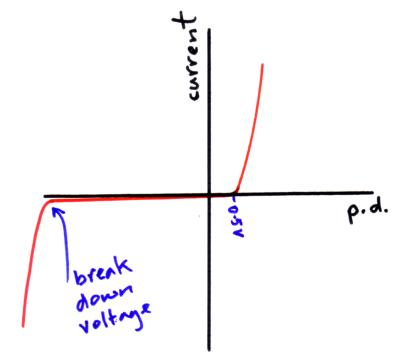Electricity
Basics
Definitions
current - the rate of flow of charge
electric potential - the amount of energy per unit charge
potential difference - the work done per unit charge (1V = 1C gaining/losing 1J)
electromotive force (emf) - the energy transferred to each unit of charge as it passes through through the source (p.d. across the cell)
resistanceis defined as its equation
Equations
Q = I t
V = W/Q
R = V/I
Current-Voltage Characteristics
At A-level, you need to:
- know the shapes of the characteristics for an ohmic component, a filament bulb and a diode (V on horizontal axis and I on vertical and vice versa)
- be able to explain why the characteristics for each component are the shape they are
- describe an experimental process that will let you collect valid data to obtain the characteristic for a component
Ohmic component
![]()
- the potential difference is directly proportional to the current (straight line through origin) - Ohm’s law
- this means there is a constant resistance
Filament bulb
![]()
- at a low current, the potential difference is directly proportional to the current
- as the current increases, the temperature increases causing the ion lattice to vibrate more making it harder for electrons to flow meaning the resistance has increased
- for a given p.d., the current is less than for an ohmic conductor
Semiconductor diode

- in the forward bias direction, the resistance rapidly decreases after roughly 0.7V
- in the negative direction, there is a very high resistance (around 0 current) until voltage breakdown at -50V where there is basically 0 resistance
Potentiometer circuit
Potentiomenter circuits are used to find the characteristics for different components. They must be used in favour of just a variable resistor, as they provide a full range of currents (particularly I = 0A)

- when using this circuit to determine the characteristic of a semiconductor diode, a protective (or ballast) resistor must be used to protect the circuit components from too high a current
Resisitivity and Superconductors
Resistivity
resistivity is defined by the equation:
resistivity = resistance x cross-sectional area / length
or ρ = (RA) / L
where resistance is measured in ohms, length is measured in meters and area is measured in metres squared, meaning the unit of resistivity is the ohm meter (Ωm)
Thermistors - UNFINISHED
Superconductors
a superconducting material is one with no resistivity below a critical temperature (often very low)

Uses of superconductors
- MRI scans - the weak resistance of superconductors allows very strong currents to flow with no heating in the material, and hence enables to get very high field values
- particle accelerators - they can produce very strong magnetic fields (due to high current) and particle accelerators use magnetic fields to accelerate the particles
- transformers and generators - they reduce energy dissipation in the transmission of electric power and reduce the fire risk
- microchips
- Maglev trains
Advantages of superconductors
- reduces energy dissipation
- high-speed operation
- high sensitivity
- can generate large magnetic fields
Disadvantages of superconductors
- only useful below critical temperature (often requires expensive cryogenic technology)
- brittle
- expensive